NARX Deep Convolutional Fuzzy System for Modelling Nonlinear Dynamic Processes
Abstract
1. Introduction
2. Materials and Methods
2.1. Nonlinear Dynamic Input/Output Models Based on External Dynamics
2.2. WM Fuzzy System
2.3. Deep Convolutional Fuzzy System
2.4. Nonlinear Dynamic Input/Output Models Based NARX DCFS
2.4.1. Different NARX DCFS Structures
2.5. Fast Training Algorithm for NARX DCFS Structures
| Algorithm 1 | ||
|---|---|---|
| Step 1. Choose the structure of the NARX DCFS. Define the , , of regression vector . Define the NARX DCFS structure and the way the NARX regression vector is mapped to the DCFS input vector . Create data pair for DCFS training . Step 2. Choose the structure of the DCFS. Define the number hierarchical levels of the DCFS of L, the number of nl fuzzy subsystems in each level, and the number of inputs to the fuzzy subsystems , (moving window ). Choose the moving scheme . Choose the number of fuzzy sets for all inputs and all Step 3. Design the first level (i = 1, 2,) in the form of (8), using the WM method [24,25,26], where the data pairs are . Step 3.1. For each cell with set the initial values of the weight parameter and the weight output parameter equal to zero. Step 3.2. For each input to , consider the fuzzy sets , with membership functions of triangular shape, symmetrically arranged as in the Figure 2, and choose the endpoints as | ||
| (10) | ||
| Step 3.3. For each data pair determine the fuzzy sets that achieve the maximum membership values among the fuzzy sets at . Determine | ||
| (11) | ||
| Step 3.4. Update the weight parameters and weight output parameters for cell | ||
| (12) | ||
| Step 3.5. Repeat Steps 3.3 and 3.4 for . For the cells with , determine the parameters in the of (8) as | ||
| . | (13) | |
| Cells with are covered by data, and define | ||
| . | (14) | |
| Step 3.6. For each cell not in , search its neighbors to see whether they are in , where two cells, and , are neighbours to each other if for all except at one location r, such that the or . For the cells not in that have at least one neighbor in , determine the as the average of the ’s of its neighbors in . Define | ||
| (15) | ||
| Step 3.7. Repeat Step 3.6 with replaced by , and replaced by , and continue this process to get , , that contain the cells with . For more features of the Wang–Mendel (WM) method and a detailed description, refer to [25,26]. | ||
| Step 4. Repeat Step 2 for l = 2 up to L, designing the FSs at all levels. For example, for level l we design the s , , assuming that, in the previous step, we have designed all FSs from level l-1. | ||
| Step 4.1. For each put , ,, input to DCFS level 1 and compute upwards along the DCFS to get the outputs of level l-1. The outputs of FSs of level l-1 are denoted by . We create new input–output data pairs for designing the level l . | ||
| Step 4.2. Repeat Step 3, and train the level l , with the new input–output data pairs , with k = 1,2⋯N. | ||
| Step 4.3. Set the l = l +1 and repeat Steps 4.1 and 4.2 until the last on the level L is designed. | ||
3. Experimental Studies
3.1. Gas Furnace Model Identification
3.2. Nonlinear Dynamic Test Processes Identification
- For a Hammerstein system, which is the typical coupling of a static non-linear function and a dynamic linear system, the example is given by a differential equation:
- As the opposite, a Wiener system is a linear dynamic system in series with a static, non-linear function, and the example is given by a differential equation:
- A nonlinear differential equation (NDE) system is the approximation of a non-minimum phase system of a second order with parameters: gain 1, time constants 4 s and 10 s, and a zero at 0.25 s. Output feedback is a parabolic nonlinearity:
- A not separable dynamic (NSD) system has a nonlinearity which cannot be divided into a static non-linear part and a dynamic linear part. The behaviour of the system depends on the input variable:
4. Discussion
- The hierarchical multilevel structure of DCFS allows the approximator of a non-linear function to be implemented with many more inputs in the regressor vector and without exponential growth in the number of rules.
- There are many different possibilities when creating a DCFS input vector from a regression vector. This allows us to have different structures. In this work, we present three of them.
- The training algorithm remains non-iterative, as is typical for DCFS. The N input–output data are processed only once.
- The ability to predict the output of the nonlinear system is satisfactory.
- The excitation signal must be chosen appropriately, providing both an adequate frequency bandwidth and a large variety of amplitude levels.
- The results of testing with a training signal are often much better than the results with a test signal, such as in Figure 6b.
- Once the NARX DCFS parameters and the input signal have been selected, the prediction results cannot be improved by repeating the training procedure.
5. Conclusions
Supplementary Materials
Funding
Institutional Review Board Statement
Informed Consent Statement
Data Availability Statement
Acknowledgments
Conflicts of Interest
References
- Škrjanc, I.; Iglesias, J.A.; Sanchis, A.; Leite, D.; Lughofer, E.; Gomide, F. Evolving Fuzzy and Neuro-Fuzzy Approaches in Clustering, Regression, Identification, and Classification: A Survey. Inf. Sci. 2019, 490, 344–368. [Google Scholar] [CrossRef]
- Nelles, O. Nonlinear System Identification; Springer: Berlin/Heidelberg, Germany, 2001; ISBN 978-3-642-08674-8. [Google Scholar]
- Tong, R.M. The Evaluation of Fuzzy Models Derived from Experimental Data. Fuzzy Sets Syst. 1980, 4, 1–12. [Google Scholar] [CrossRef]
- Pedrycz, W. An Identification Algorithm in Fuzzy Relational Systems. Fuzzy Sets Syst. 1984, 13, 153–167. [Google Scholar] [CrossRef]
- Takagi, T.; Sugeno, M. Fuzzy Identification of Systems and Its Applications to Modeling and Control. IEEE Trans. Syst. Man Cybern. 1985, SMC-15, 116–132. [Google Scholar] [CrossRef]
- Sugeno, M.; Yasukawa, T. A Fuzzy-Logic-Based Approach to Qualitative Modeling. IEEE Trans. Fuzzy Syst. 1993, 1, 7. [Google Scholar] [CrossRef]
- Su, S.-F.; Yang, F.-Y.P. On the Dynamical Modeling with Neural Fuzzy Networks. IEEE Trans. Neural Netw. 2002, 13, 1548–1553. [Google Scholar] [CrossRef]
- Kyoung Kwan Ahn; Ho Pham Huy Anh Inverse Double NARX Fuzzy Modeling for System Identification. IEEEASME Trans. Mechatron. 2010, 15, 136–148. [CrossRef]
- Zemouri, R.; Gouriveau, R.; Zerhouni, N. Defining and Applying Prediction Performance Metrics on a Recurrent NARX Time Series Model. Neurocomputing 2010, 73, 2506–2521. [Google Scholar] [CrossRef]
- Cogollo, M.R.; González-Parra, G.; Arenas, A.J. Modeling and Forecasting Cases of RSV Using Artificial Neural Networks. Mathematics 2021, 9, 2958. [Google Scholar] [CrossRef]
- Ali, W.; Khan, W.U.; Raja, M.A.Z.; He, Y.; Li, Y. Design of Nonlinear Autoregressive Exogenous Model Based Intelligence Computing for Efficient State Estimation of Underwater Passive Target. Entropy 2021, 23, 550. [Google Scholar] [CrossRef]
- Rangel, E.; Cadenas, E.; Campos-Amezcua, R.; Tena, J.L. Enhanced Prediction of Solar Radiation Using NARX Models with Corrected Input Vectors. Energies 2020, 13, 2576. [Google Scholar] [CrossRef]
- Lewis, F.L.; Campos, J.; Selmic, R. Neuro-Fuzzy Control of Industrial Systems with Actuator Nonlinearities; Frontiers in applied mathematics; Society for Industrial and Applied Mathematics: Philadelphia, PA, USA, 2002; ISBN 978-0-89871-505-7. [Google Scholar]
- De Campos Souza, P.V. Fuzzy Neural Networks and Neuro-Fuzzy Networks: A Review the Main Techniques and Applications Used in the Literature. Appl. Soft Comput. 2020, 92, 106275. [Google Scholar] [CrossRef]
- Golob, M.; Tovornik, B. Identification of Non-Linear Dynamic Systems with Decomposed Fuzzy Models. In Proceedings of the IEEE International Conference on Systems, Man and Cybernetics, Nashville, TN, USA, 8–11 October 2000; Volume 5. [Google Scholar]
- Golob, M.; Tovornik, B. Input-Output Modelling with Decomposed Neuro-Fuzzy ARX Model. Neurocomputing 2008, 71, 875–884. [Google Scholar] [CrossRef]
- Raju, G.V.S.; Zhou, J.; Kisner, R.A. Hierarchical Fuzzy Control. Int. J. Control 1991, 54, 1201–1216. [Google Scholar] [CrossRef]
- Wang, L.X. A Mathematical Formulation of Hierarchical Systems Using Fuzzy Logic Systems. In Proceedings of the 1994 IEEE 3rd International Fuzzy Systems Conference, Orlando, FL, USA, 26–29 June 1994; IEEE: Orlando, FL, USA, 1994; pp. 183–188. [Google Scholar]
- Sun, L.; Huo, W. Adaptive Fuzzy Control of Spacecraft Proximity Operations Using Hierarchical Fuzzy Systems. IEEEASME Trans. Mechatron. 2016, 21, 1629–1640. [Google Scholar] [CrossRef]
- Yu, W.; Rodriguez, F.O.; Moreno-Armendariz, M.A. Hierarchical Fuzzy CMAC for Nonlinear Systems Modeling. IEEE Trans. Fuzzy Syst. 2008, 16, 1302–1314. [Google Scholar] [CrossRef]
- Kamthan, S.; Singh, H. Hierarchical Fuzzy Logic for Multi-Input Multi-Output Systems. IEEE Access 2020, 8, 206966–206981. [Google Scholar] [CrossRef]
- Zeng, X.-J.; Goulermas, J.Y.; Liatsis, P.; Wang, D.; Keane, J.A. Hierarchical Fuzzy Systems for Function Approximation on Discrete Input Spaces With Application. IEEE Trans. Fuzzy Syst. 2008, 16, 1197–1215. [Google Scholar] [CrossRef]
- Hinton, G.E.; Osindero, S.; Teh, Y.-W. A Fast Learning Algorithm for Deep Belief Nets. Neural Comput. 2006, 18, 1527–1554. [Google Scholar] [CrossRef]
- Wang, L.-X. Fast Training Algorithms for Deep Convolutional Fuzzy Systems with Application to Stock Index Prediction. IEEE Trans. Fuzzy Syst. 2019, 28, 1301–1314. [Google Scholar] [CrossRef]
- Wang, L.-X.; Mendel, J.M. Generating Fuzzy Rules by Learning from Examples. IEEE Trans. Syst. Man Cybern. 1992, 22, 1414–1427. [Google Scholar] [CrossRef]
- Wang, L.-X. The WM Method Completed: A Flexible Fuzzy System Approach to Data Mining. IEEE Trans. Fuzzy Syst. 2003, 11, 768–782. [Google Scholar] [CrossRef]
- Jang, J.-S.R. ANFIS: Adaptive-Network-Based Fuzzy Inference System. IEEE Trans. Syst. Man Cybern. 1993, 23, 665–685. [Google Scholar] [CrossRef]
- Golob, M.; Tovornik, B. Decomposed Neuro-Fuzzy ARX Model. In Advances in Soft Computing—AFSS 2002; Pal, N.R., Sugeno, M., Eds.; Lecture Notes in Computer Science; Springer: Berlin, Heidelberg, 2002; Volume 2275, pp. 260–266. ISBN 978-3-540-43150-3. [Google Scholar]
- Box, G.E.P.; Jenkins, G.M. Time Series Analysis: Forecasting and Control; Holden-Day: San Francisco, CA, USA, 1970; ISBN 978-0-8162-1094-7. [Google Scholar]
- Xu, C.; Lu, Y. Fuzzy Model Identification and Self-Learning for Dynamic Systems. IEEE Trans. Syst. Man Cybern. 1987, 17, 683–689. [Google Scholar] [CrossRef]
- Branco, P.J.C.; Dente, J.A. A New Algorithm for On-Line Relational Identification of Nonlinear Dynamic Systems. In Proceedings of the 1993 Second IEEE International Conference on Fuzzy Systems, San Francisco, CA, USA, 28 March–1 April 1993; IEEE: San Francisco, CA, USA, 1993; pp. 1173–1178. [Google Scholar]
- Cartagena, O.; Parra, S.; Munoz-Carpintero, D.; Marin, L.G.; Saez, D. Review on Fuzzy and Neural Prediction Interval Modelling for Nonlinear Dynamical Systems. IEEE Access 2021, 9, 23357–23384. [Google Scholar] [CrossRef]
- Zou, W.; Li, C.; Chen, P. An Inter Type-2 FCR Algorithm Based T–S Fuzzy Model for Short-Term Wind Power Interval Prediction. IEEE Trans. Ind. Inform. 2019, 15, 4934–4943. [Google Scholar] [CrossRef]
- Wang, J.; Peng, Z.; Wang, X.; Li, C.; Wu, J. Deep Fuzzy Cognitive Maps for Interpretable Multivariate Time Series Prediction. IEEE Trans. Fuzzy Syst. 2021, 29, 2647–2660. [Google Scholar] [CrossRef]
- Xue, C.; Mahfouf, M. A New Deep Complex-Valued Single-Iteration Fuzzy System for Predictive Modelling. In Proceedings of the 2022 IEEE International Conference on Fuzzy Systems (FUZZ-IEEE), Padua, Italy, 18–23 July 2022; IEEE: Padua, Italy, 2022; pp. 1–7. [Google Scholar]
- Wang, Y.; Liu, H.; Jia, W.; Guan, S.; Liu, X.; Duan, X. Deep Fuzzy Rule-Based Classification System With Improved Wang–Mendel Method. IEEE Trans. Fuzzy Syst. 2022, 30, 2957–2970. [Google Scholar] [CrossRef]
- Kaya, E. A New Neural Network Training Algorithm Based on Artificial Bee Colony Algorithm for Nonlinear System Identification. Mathematics 2022, 10, 3487. [Google Scholar] [CrossRef]
- Yan, S.; Zhou, J.; Zheng, Y.; Li, C. An Improved Hybrid Backtracking Search Algorithm Based T–S Fuzzy Model and Its Implementation to Hydroelectric Generating Units. Neurocomputing 2018, 275, 2066–2079. [Google Scholar] [CrossRef]
- Ustundag, B.B.; Kulaglic, A. High-Performance Time Series Prediction With Predictive Error Compensated Wavelet Neural Networks. IEEE Access 2020, 8, 210532–210541. [Google Scholar] [CrossRef]
- Waheeb, W.; Ghazali, R. Forecasting the Behavior of Gas Furnace Multivariate Time Series Using Ridge Polynomial Based Neural Network Models. Int. J. Interact. Multimed. Artif. Intell. 2019, 5, 126. [Google Scholar] [CrossRef]
- Lyu, J.; Liu, F.; Ren, Y. Fuzzy Identification of Nonlinear Dynamic System Based on Selection of Important Input Variables. J. Syst. Eng. Electron. 2022, 33, 737–747. [Google Scholar] [CrossRef]
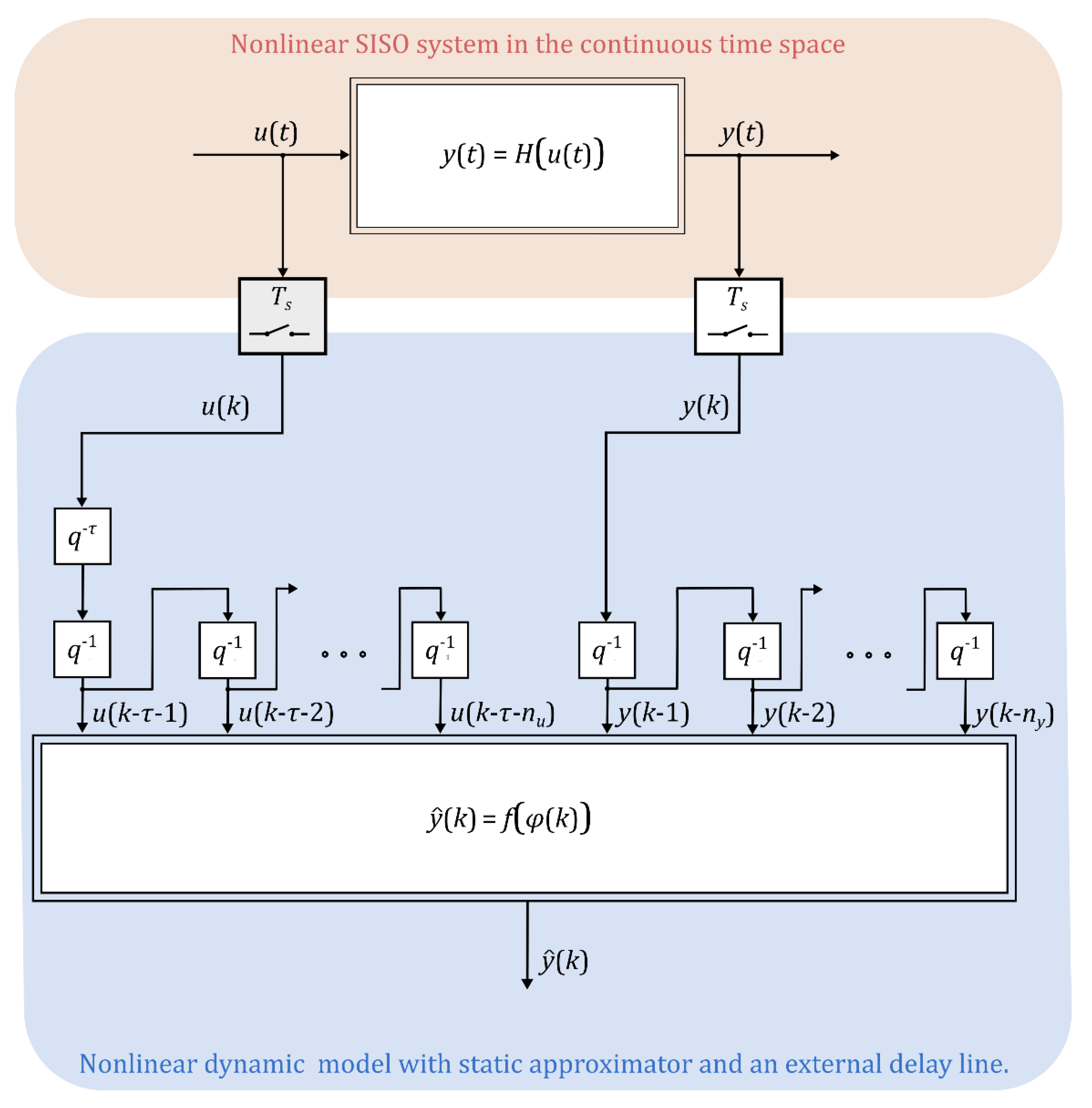
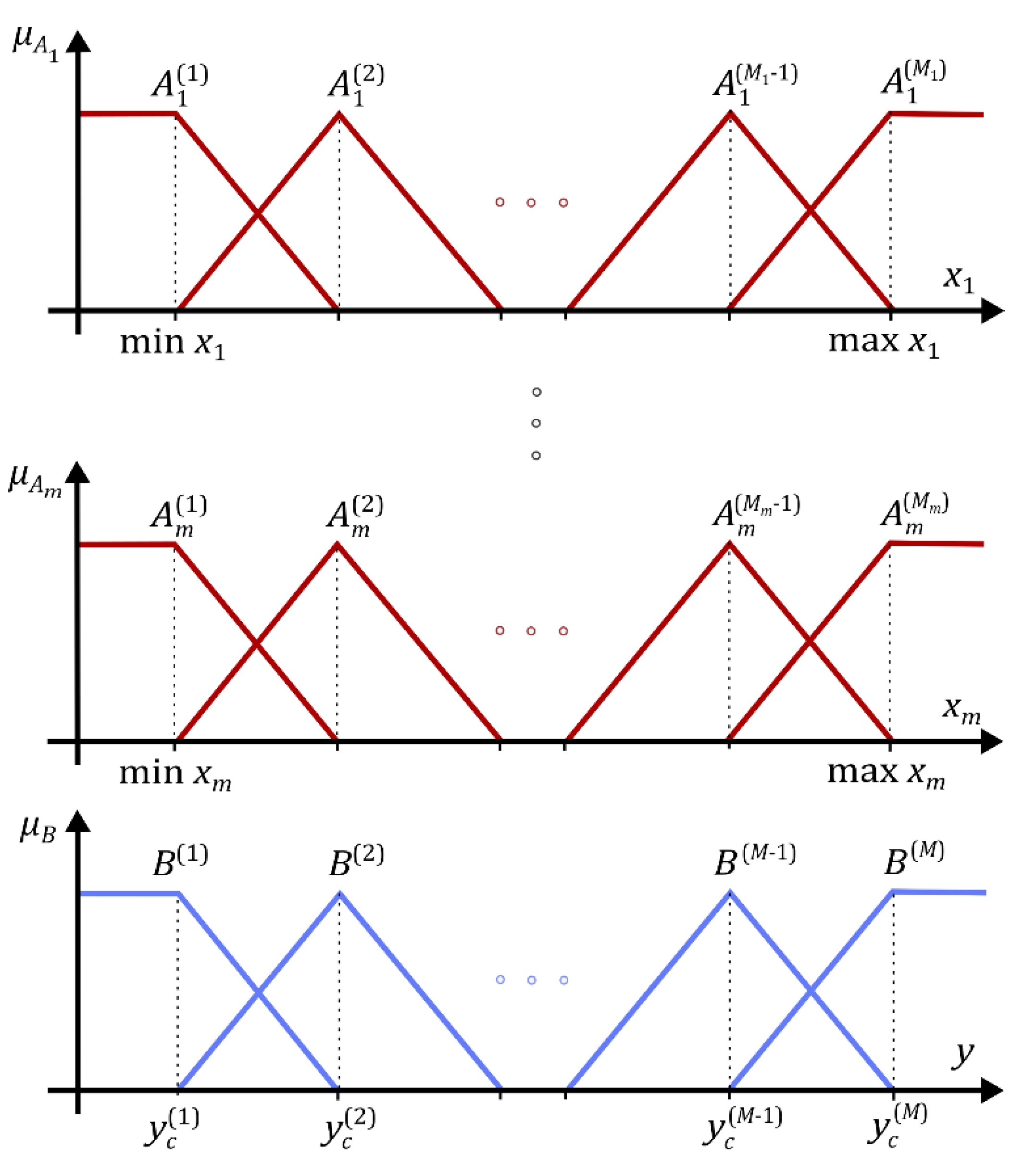
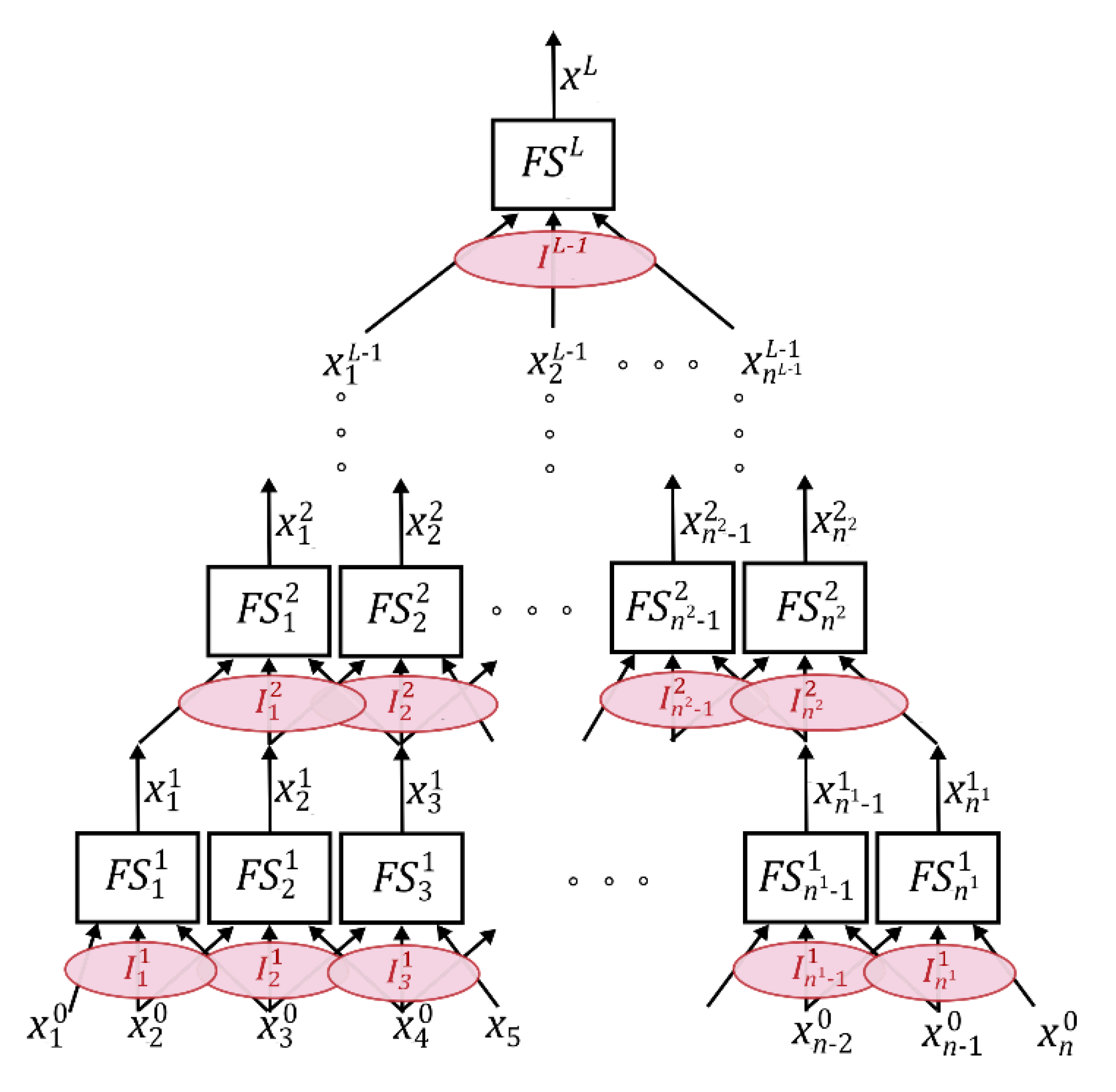

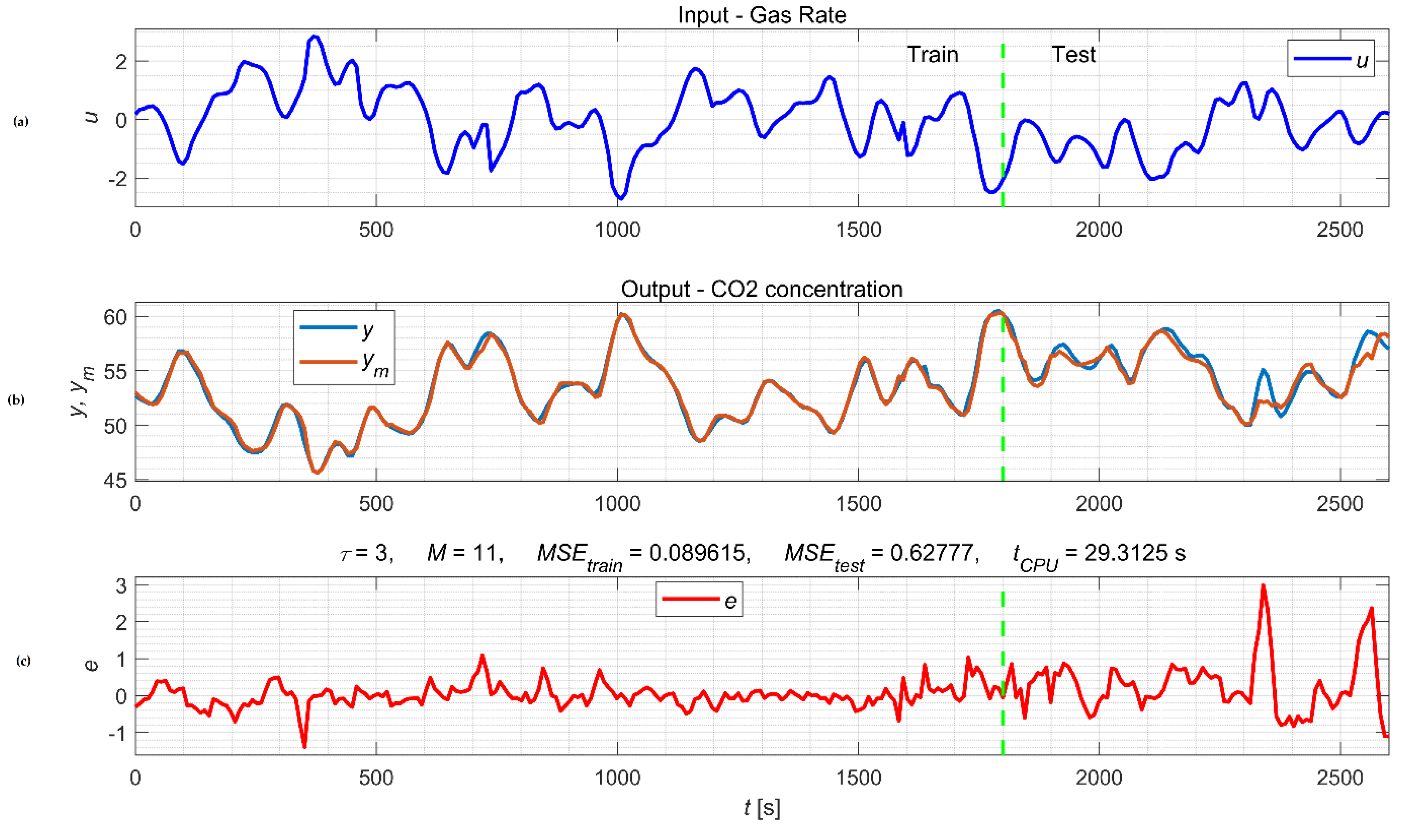
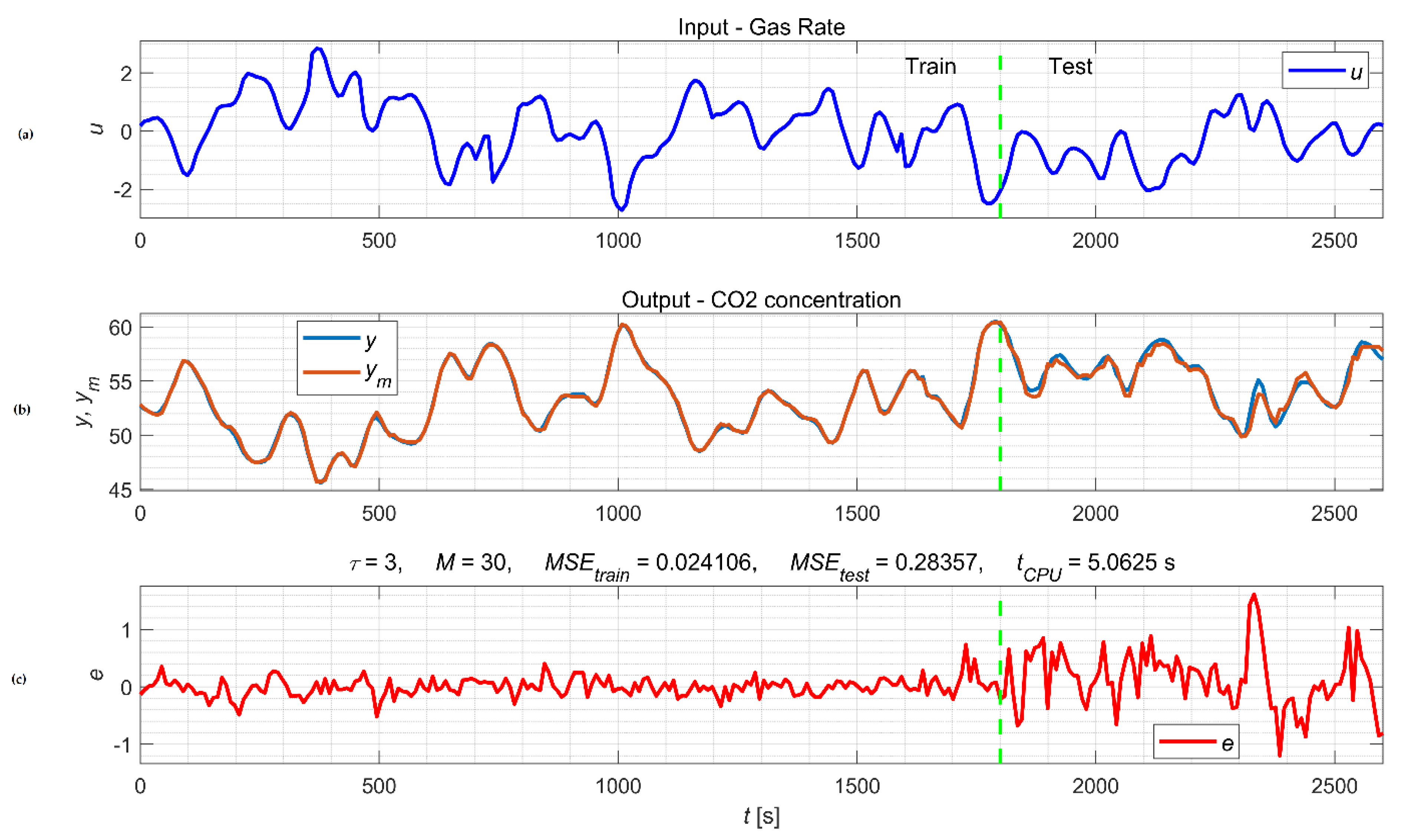

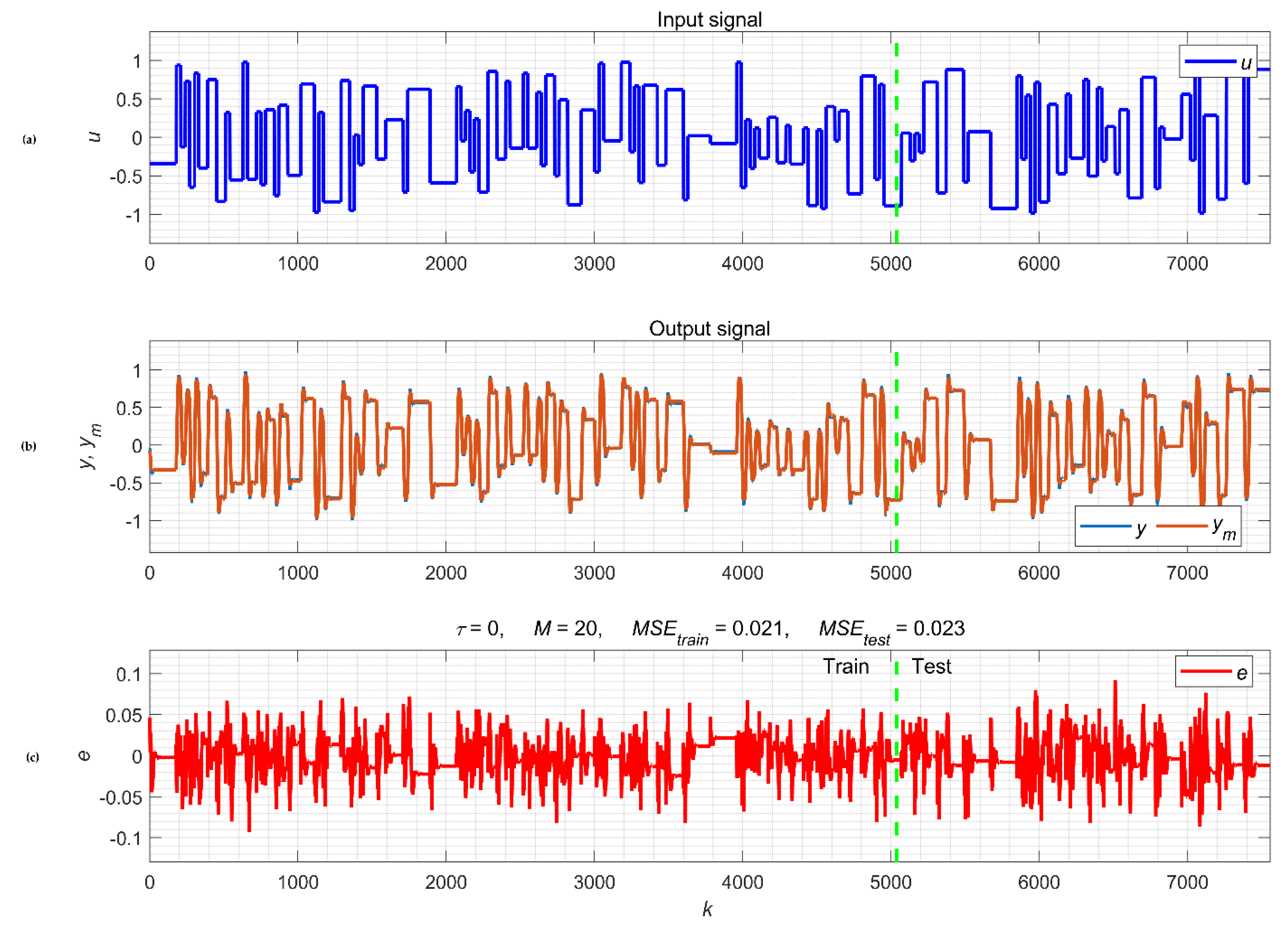

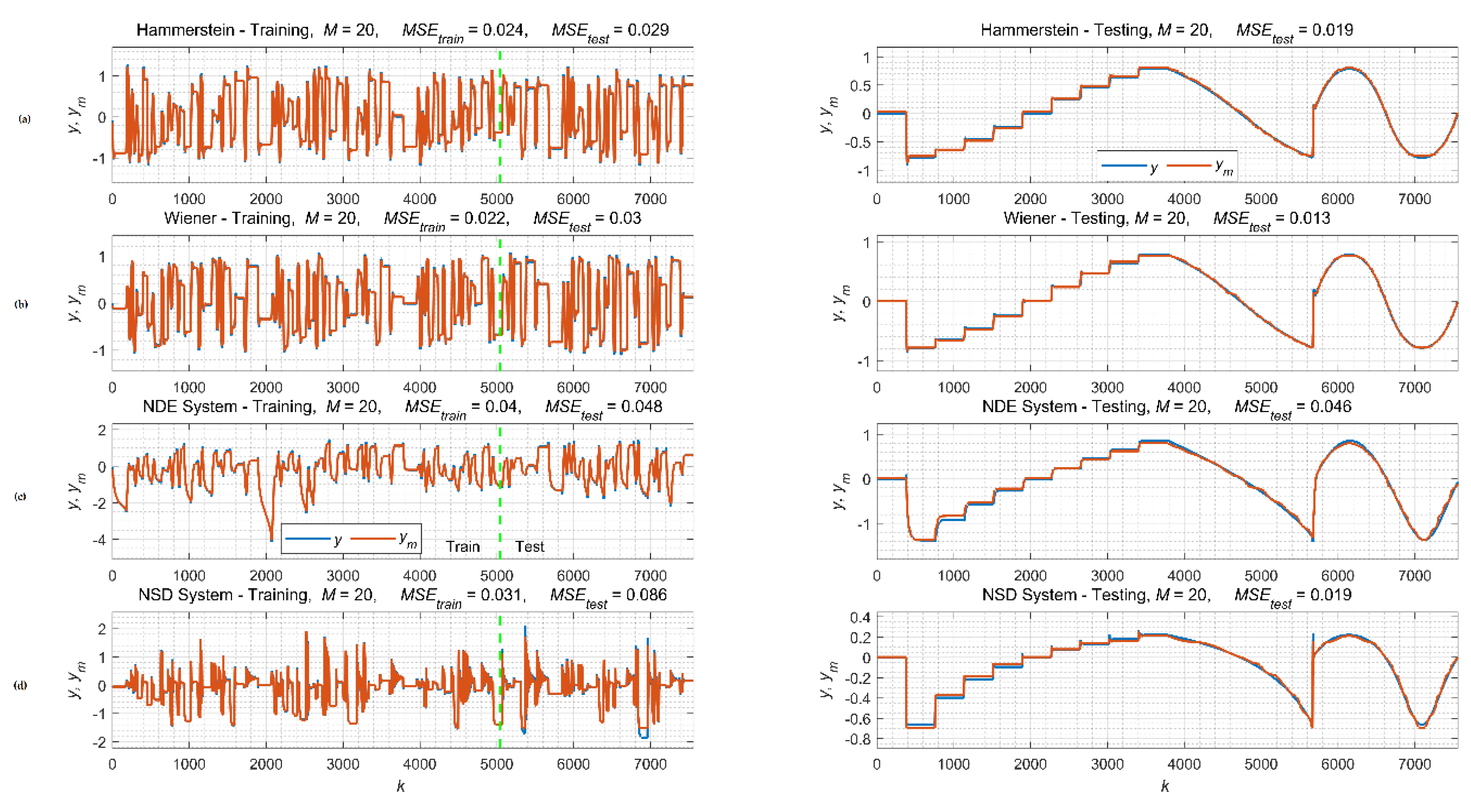
| Model | Regression Vector φ(k) |
|---|---|
| NTS | |
| NARX | |
| NARMAX | |
| OE |
| Model | M | MSEtrain | MSEtest | tCPU [s] | |
|---|---|---|---|---|---|
| 3 | 5 | 0.28235 | 0.76069 | 1.10 | |
| 3 | 7 | 0.17843 | 0.54243 | 3.21 | |
| WM FS (7) [26] | 3 | 11 | 0.08962 | 0.62777 | 29.32 |
| 3 | 13 | 0.05681 | 0.55120 | 94.25 | |
| 3 | 15 | 0.04051 | 0.90677 | 261.52 | |
| 3 | 5 | 0.49303 | 0.38133 | 0.79 | |
| General NARX DCFS | 3 | 15 | 0.11042 | 0.32413 | 1.83 |
| 3 | 30 | 0.02411 | 0.28357 | 5.07 | |
| 3 | 5 | 0.45535 | 0.50022 | 0.77 | |
| Input-output NARX DCFS | 3 | 15 | 0.12208 | 0.24639 | 1.18 |
| 3 | 30 | 0.04537 | 0.4484 | 3.58 | |
| 3 | 5 | 0.38298 | 0.59655 | 0.50 | |
| Sub-model NARX DCFS | 3 | 15 | 0.13069 | 0.34904 | 0.85 |
| 3 | 30 | 0.03697 | 0.58240 | 1.11 |
| Reference | No. of Variables | MSE |
|---|---|---|
| Box Jenkins [29] | - | 0.71 |
| Tong [3] | y(k-1), u(k-4) | 0.469 |
| Pedrycz [4] | y(k-1), u(k-4) | 0.320 |
| Xu [30] | y(k-1), u(k-4) | 0.328 |
| Costa Branco [31] | y(k-1), u(k-4) | 0.312 |
| Sugeno-Yasukawa [6] | y(k-1), y(k-2), y(k-3) u(k-1), u(k-2), u(k-3) | 0.190 |
| Takagi Sugeno [5] | y(k-1), u(k-3), u(k-4) | 0.068 |
| Golob ARX min-max [15] | y(k-1), u(k-4) | 0.73 |
| Golob ARX sum-prod [15] | y(k-1), u(k-4) | 0.57 |
| Golob DNF ARX [16] | y(k-1), u(k-4) | 0.196 |
| General NARX DCFS | y(k-1), y(k-2), y(k-3), u(k-4), u(k-5), u(k-6) | 0.024 |
Disclaimer/Publisher’s Note: The statements, opinions and data contained in all publications are solely those of the individual author(s) and contributor(s) and not of MDPI and/or the editor(s). MDPI and/or the editor(s) disclaim responsibility for any injury to people or property resulting from any ideas, methods, instructions or products referred to in the content. |
© 2023 by the author. Licensee MDPI, Basel, Switzerland. This article is an open access article distributed under the terms and conditions of the Creative Commons Attribution (CC BY) license (https://creativecommons.org/licenses/by/4.0/).
Share and Cite
Golob, M. NARX Deep Convolutional Fuzzy System for Modelling Nonlinear Dynamic Processes. Mathematics 2023, 11, 304. https://doi.org/10.3390/math11020304
Golob M. NARX Deep Convolutional Fuzzy System for Modelling Nonlinear Dynamic Processes. Mathematics. 2023; 11(2):304. https://doi.org/10.3390/math11020304
Chicago/Turabian StyleGolob, Marjan. 2023. "NARX Deep Convolutional Fuzzy System for Modelling Nonlinear Dynamic Processes" Mathematics 11, no. 2: 304. https://doi.org/10.3390/math11020304
APA StyleGolob, M. (2023). NARX Deep Convolutional Fuzzy System for Modelling Nonlinear Dynamic Processes. Mathematics, 11(2), 304. https://doi.org/10.3390/math11020304






